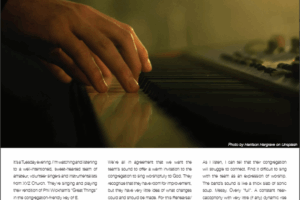Take this link to read the full article about Grant's More Than Music Workshops, as…

WIRELESS SYSTEMS: THE WIRELESS MIC & THE MUSICIAN
By Grant Norsworthy
Dear Church Audio Tech,
I want to write to you today about wireless microphones. With me being a musician, singer and speaker – and you an audio tech – we are quite literally at opposite ends of the signal chain. How we perceive and interact with this particular piece of audio technology is entirely opposite. Our roles and responsibilities are WAY different.
I hope this letter gives a bit better understanding of my perspective.
First, let me say that I am VERY grateful for the role you fill. I could not do what you do! With all those complicated faders, knobs, numbers, meters, screens and lights, my brain would explode. I just don’t operate well in that environment. Thanks for being the audio tech – the smooth operator – that you are. Even though I may not always show it, or say it as often as I should, I could not do what I do without you! It takes both you and I filling our different roles to achieve our common goal.
So, wireless microphones are great for me, sure. (Shure?) The freedom to move across the platform and still be heard, certainly helps me as a communicator. I don’t like being bound to one position by a mic! Not having to worry about getting caught up in wires and cables is incredibly freeing. I remember, way back before going wireless, I got myself into more than one embarrassing bind involving mic cables as I tried (unsuccessfully) to move from point A to point B!
I certainly have appreciated the huge improvements in the technology over the years. I’ve been around long enough to remember how unreliable wireless microphones used to be: How often the signal would drop out or interference would be heard. What? Is that a taxi radio blaring through front of house? We can laugh now, but it wasn’t so funny back then. Thanks for keeping the hardware as current as you can.
This reminds me of the financial expense of wireless-ness! I know, not so many years ago a good wireless microphone and receiver (that had at least a chance of delivering a clean, reliable signal) would cost an arm and a leg! Not so now. Today, even the smallest of churches seem able to afford a wireless microphone or six with brands like Sennheisser, Shure and Audio-Technica all producing excellent, affordable systems.
But I confess – I never had to pay those big bucks. Someone else – more related to tech – always paid the price and I just enjoyed the benefits. I guess the financial cost of wireless-ness comes out of your budget, not mine.
Here’s the thing: I have only recently come to realize that, while it’s me that enjoys the freedom of wireless microphones, they actually have significantly increased your workload over good ol’ cabled microphones. My demands – and the demands of singers, speakers and musicians like me – to be wireless have given you several more tasks to deal with!
You’ve had to learn about coordinating frequencies, antenna positioning, reducing interference, signal blockage and a whole lot of other tech stuff that just makes my head spin. Not only that, you’ve had to know how to trouble-shoot when the system is not working properly. Thanks for taking (another) one for the team.
You have to make sure each and every wireless transmitter has a full battery charge before each use! I assume that takes quite a lot of time, a bullet-proof system of management and considerable, ongoing expense – even if you have managed to find a type of rechargeable battery that reliably gives the necessary voltage every time!
With wireless microphones, now you’ve got an extra rack of receivers in front of you. More lights, buttons, dials and signal meters. Additionally, you have to have them, or at least their antennae, positioned above the heads of the congregation – in a clear line of sight to the microphones – to avoid signal blockage. In that position, this gear most likely restricts your view in one direction or another.
More than that, each mic receiver has yet another gain level to adjust before the signal gets to the fader on your mixing console! Another layer to peel away during sound check. Another gain adjustment that, if not set correctly, could invite unwanted noise issues, or the “clipping” of digital distortion. More work for the already overworked audio tech!
But please know that I don’t think about any of this – especially when I’m actually up there on the platform. My head is usually completely full of my stuff – how the song goes, what the words are, what I’m going to say, assessing how the congregation are responding, doing my best to (hopefully) discern the leading of the Holy Spirit. For the most part, I am oblivious to what you have to deal with from your end of the signal chain. To be honest, I’m only vaguely cognisant of my mic being wired or wireless most of the time.
Still, I’d like to continue to benefit from the undeniable advantages that wireless microphones give me. I’d like you to keep going the extra mile to provide platform-dwellers like me with the wireless advantage. I am sorry for never really expressing my gratitude that you have had to work even harder to provide me with this gift. I guess that we who inhabit the platform are a weird bunch. We tend to carry ourselves as if we are entitled to your hard work and skills – that everything that can be done for us should be done. I’m sure we can come across as pretty arrogant, selfish and thoughtless sometimes.
So, on behalf of all those who get to enjoy the benefits of wireless microphones (and all the other audio teching you do that we don’t understand nor fully appreciate) may I offer a heartfelt apology – I’m sorry – and a sincere thanks. You rock!
And I make this pledge to you: Next time a battery dies during the service, or the signal drops, or the mic isn’t switched on, I promise not to glare accusingly towards the audio booth.
Sincerely,
Grant Norsworthy
P.S. Also, I will try harder to remember to switch off my mic between rehearsal and the service in future … as you have patiently asked me to do on multiple occasions.
This article was first published by Worship Tech Director of the WFX Network on 6 June, 2019.


